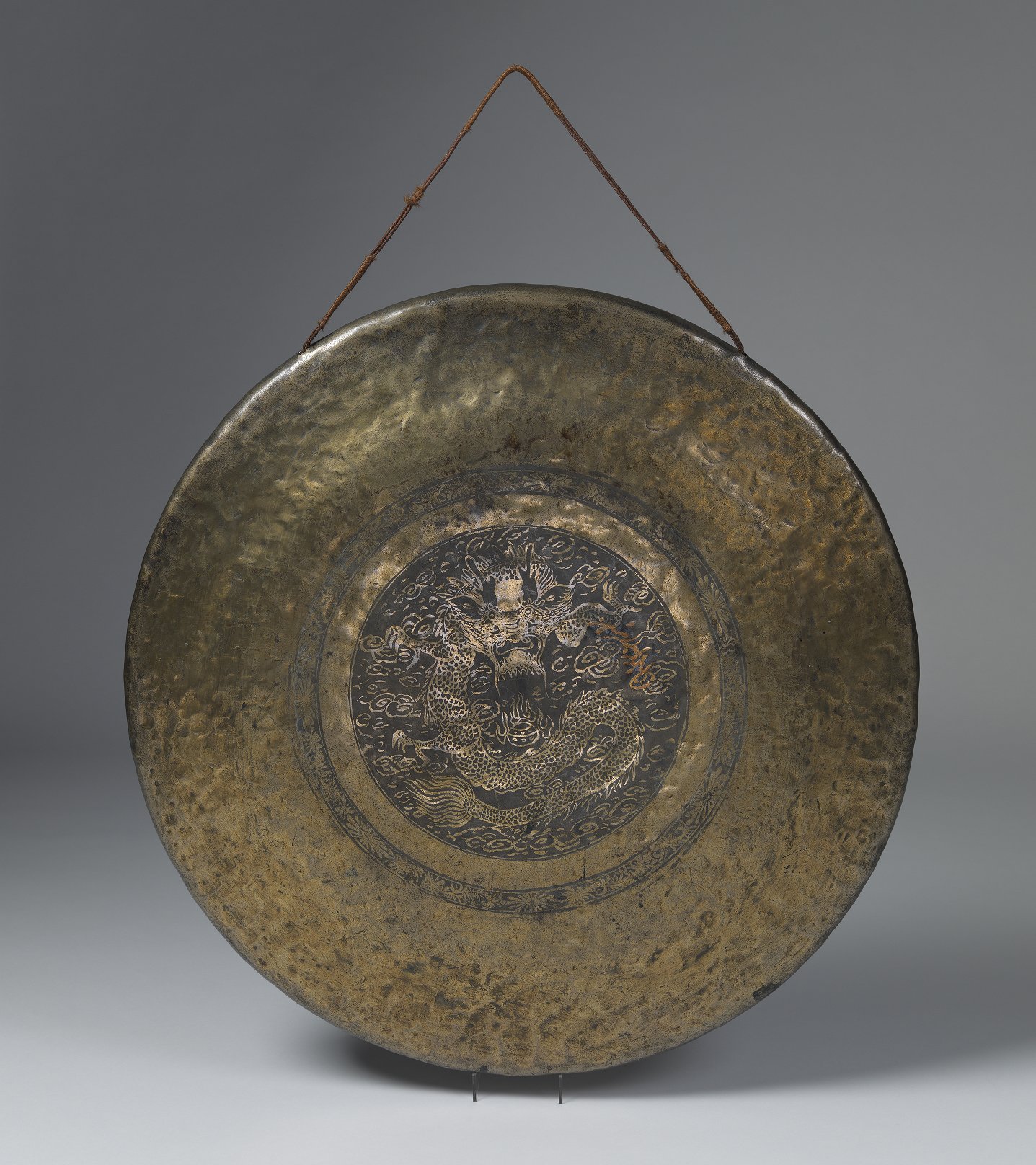Tam-tam
Melodic Percussions
Asia
Between 1001 and 1900 AD
Video
The tam-tam is a large, flat percussion instrument classified as a type of gong. It produces a powerful and resonant sound, characterized by its indefinite pitch and rich harmonic overtones.
Construction
Material: The tam-tam is typically made from bronze or sheet bronze, which can be either cast or hammered. The quality of the metal influences the instrument’s sound characteristics.
Design: It features a round, slightly convex disc with a narrow, turned-up rim. The diameter of a tam-tam can range from approximately 35 cm to 170 cm (about 14 to 67 inches), and it usually has a thickness of 1 to 3 mm. Weights can vary significantly from around 0.5 kg to 50 kg depending on size and material
Suspension: The instrument is suspended using cords threaded through holes in the rim, allowing it to vibrate freely when struck.
Sound Characteristics
Sound Quality: The tam-tam produces a loud, booming sound that builds up and shimmers before fading away. It contains many inharmonic partials, giving it a noise-like character rather than a specific pitch
Playing Techniques: Striking the tam-tam off-center (about a hand-width from the middle) yields the best volume and lowest notes. It can be played with various mallets—soft mallets produce a warm sound, while harder mallets create sharper tones. Additional techniques include scraping with different implements or bowing the surface for ethereal effects.
History of the Tam-Tam
The tam-tam is a large percussion instrument that has a rich and varied history, tracing its origins back thousands of years. Its development and cultural significance span across different regions, particularly in Asia and Europe.
Ancient Origins
- The earliest known tam-tams date back to around the 7th century BC in China, where they were used in religious ceremonies and rituals. These early metal discs were integral to musical ensembles, often played in orchestras that featured multiple gongs and other instruments.
- In ancient Chinese culture, the tam-tam was not only a musical instrument but also a tool for communication and signaling during important events. It was used to mark significant occasions such as births, victories, and funerals.
Spread to East Asia
- Following its origins in China, the tam-tam spread throughout East Asia, where it became a staple in various musical traditions. Gamelan orchestras in Indonesia, for example, incorporated similar metal discs into their performances, highlighting the instrument’s importance in regional music.
Introduction to Europe
- The tam-tam was introduced to Europe likely during the 17th century, coinciding with the Turkish wars. It gained popularity for its dramatic sound and was initially used in specific ceremonial contexts, particularly during mourning rituals.
- By the late 18th century, the tam-tam began to be integrated into Western orchestras. The first notable use in symphonic music was by composer François Joseph Gossec in 1791, marking its transition into classical music settings.
19th and 20th Centuries
- Throughout the 19th century, the tam-tam’s role evolved within orchestras. Composers like Giacomo Meyerbeer utilized it to enhance dramatic moments in operas. Its use became more common among Romantic composers, who appreciated its ability to add depth and resonance to orchestral textures.
- By the early 20th century, the tam-tam established itself as a standard orchestral instrument. It was employed not just for special effects but as a fundamental component of the percussion section, contributing to the overall sound palette of orchestral music.
Modern Usage
In contemporary music, the tam-tam has found applications beyond classical genres. It is used in various styles, including ethnic music and rock, showcasing its versatility. The instrument can be struck, rubbed, or played with different objects to produce a wide range of sounds.
Notably, it was first used as a solo instrument by composer Karlheinz Stockhausen in his piece Mikrophonie I (1964), further expanding its role in modern compositions.
FAQ
What materials is a Tam-tam made of?
A tam-tam, or gong, is typically made of a large, flat disc of metal, usually bronze or brass, which is an alloy of copper and tin. It is crafted by hammering and shaping the metal to achieve the desired size, thickness, and tonal quality. The tam-tam is suspended on a frame and struck with a mallet, producing deep, resonant sounds.
How to make an tam-tam?
To make a tam-tam, start with a sheet of bronze or brass, an alloy of copper and tin. Cut it into a circular shape and heat it to soften the metal. Hammer the surface evenly to create the desired thickness and to enhance its resonance. Polish the edges and surface for smoothness, then drill small holes at the top to attach cords or a frame for suspension. Finally, test and tune it by striking with a mallet to ensure it produces the desired deep, resonant tone.
How does Agogô work?
A tam-tam works by producing sound when its metal surface is struck with a mallet. The strike causes the metal to vibrate, creating deep, resonant tones that can vary in intensity depending on the force and striking location. The vibrations spread across the tam-tam's surface, generating rich overtones and a powerful, sustained sound. It is often used for dramatic effects in orchestral and ceremonial music.
In which countries tam-tam famous?
The tam-tam is famous in many countries, particularly in China and other East Asian nations where it has historical and cultural significance. It is also widely used in Western countries, especially in orchestral and cinematic music, where its dramatic sound is appreciated. The tam-tam has become popular globally in various musical traditions and performances.
Other Instrument
Categories



















